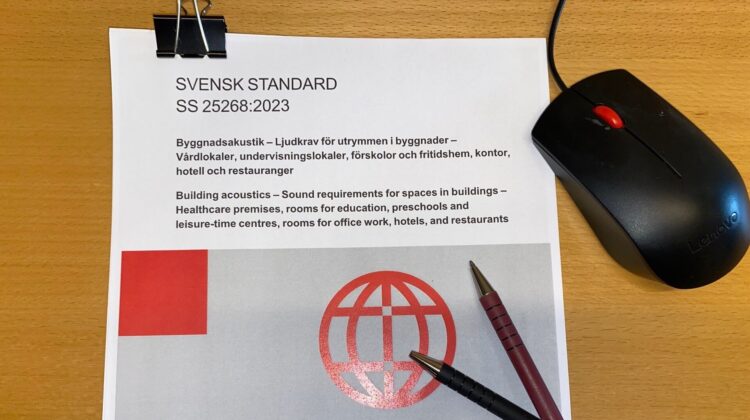
Introduced in April 2023 the renewed room acoustic standard SS 25268:2023 [1] for the Swedish market is now less than a year old. The background and purpose of the standard is, among other things, to supplement the Swedish National Board of Housing, Building and Planning’s building regulations and other governing documents and to facilitate planning and design. Another important parameter is to clarify the division of responsibilities between the various players in the construction process.
Renewed room acoustic standard
Significant differences from the previous edition are as follows:
- There is an increased focus on the acoustic needs of the rooms instead of the name of the room. Thus replacing the previous sound classes A to D with two new requirement levels: Basic and Enhanced requirements.
- An essential addition to this new edition is the informative Annex B which acts as a guidance document and, as the name suggests, is informative and supports a focus on activities in the room.
- The changes also include a new way of measuring sound insulation, where weighted standardised sound level difference is replaced by field reduction figures.
- In room acoustics, the reverberation time for 125 Hz has been incorporated into the tables. This is to ensure that the low-frequency sounds get a greater focus and are easier to identify in the tables.
- Educational facilities are now one segment and are not divided into higher and lower education as before.
- It includes a requirement level for teaching spaces. This is in line with the idea of an equal school for all, where all students deserve a good sound environment. In addition, the requirement for a difference in sound level pressure for confidentiality of conversations has been tightened.
- Hotels and restaurants now have the same table value as office premises and are seen as one segment.
- Requirement values for healthcare premises have been coordinated with guidelines for acoustic requirements issued within the Program for Technical Standards, PTS. PTS is a national network where affiliated Regions cooperate to create guidelines on design details anchored in scientific research and clinical experience.
Room function and activity
For a person who does not work with acoustics daily, there are many new terms to understand, and the Annex B is very helpful in room acoustic design. If we look specifically at room acoustics in the different segments, there is, as mentioned before, a greater focus on low-frequency sounds. And a clearer focus on wall absorbents with absorption class A. Highlighting the reverberation time in the low-frequency sounds benefits all people. Low-frequency sound can make us more tired and can interfere with the perception of speech, which is essential for learning. To improve speech communication, the walls of the space can be fitted with wall absorbents corresponding to at least 8% of the total wall area of the room and absorption class A according to SS-EN ISO 116545 [2].
In the healthcare sector, the operating room now has a shorter reverberation time of <0.5 seconds (previously <0,6 seconds). This change is beneficial as it improves speech clarity and reduces sound levels during conversations. The operating room can be a challenging space as you cannot freely move closer to others to hear better when there are hygiene zones within the room. Healthcare squares with a function similar to an open plan office, are a new room concept that is classified as such when it exceeds 100 square meters. To determine the suitable reverberation time for a healthcare square, a specialized acoustic investigation must be conducted by an acoustician.

In addition to merging with hotels, the office premises also have a greater focus on digital meetings. The need for this type of room became clear during the pandemic. Also in this chapter, there are room types that require a calculation and take into account the volume of a room and not just the area. In rooms for digital meetings, the walls of the room must be fitted with 12 % of the room’s total wall area with absorption class A wall absorbents.
The standard no longer describes room types but rather function and activity. The client should therefore define what type of activity the room should have and not just focus on the name of the room. In conclusion, we see many positive effects of the standard that benefit us all, whether you are in a hospital or work in a preschool.
Everyone needs good acoustics and hearing is one of our five senses that we need to take care of.
[1] SS 25268:2023 Building acoustics – Sound requirements for spaces in buildings – Healthcare premises, rooms for education, preschools and leisure-time centres, rooms for office work, hotels, and restaurants
[2] SS-EN ISO 116545 Acoustics – Sound absorbers for use in buildings – Rating of sound absorption

